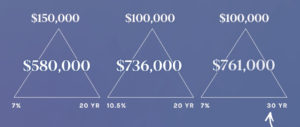Details Are Part of Our Difference
Embracing the Evidence at Anheuser-Busch – Mid 1980s
529 Best Practices
David Booth on How to Choose an Advisor
The One Minute Audio Clip You Need to Hear
The Path to Greater Returns
Charles Kafoglis leads our Hillfolio segment and produced a stellar educational resource recently titled “The Greatest Double“. Many clients connected with the message of the importance of time to the patient investor. Charles is back with a new gem called “The Path to Greater Returns”, a compelling story that extends our understanding beyond time and seeks to prove that your investment rate of return is just as important.
If you find these videos valuable, please let us know. Feel free to share this email and video with a colleague, friend, or serious saver.
You can contact us directly at Charles@HillInvestmentGroup.com or 314-448-4023 if you want to talk about your plan in more detail.
John Oliver on Jim Cramer
https://youtu.be/VAfGa5fsOm4
Whether you’re a client, friend, fellow advisor, or future client, if you’ve followed our thinking for more than a few months, you already know that we have a timeless investment philosophy: own global capitalism in a highly diversified (thousands of stocks), low-cost, tax-efficient manner rather than trying to select individual stocks or managers. Hill and our clients are investors. Jim Cramer and stock pickers are gamblers. A corollary is: remain invested all the time…good times and bad; don’t try to time the market. This brief and hilarious John Oliver video highlights the poster child of stock picking, CNBC’s Jim Cramer, and some of his “amazing” stock picks along with their results.
Let’s talk if you’re an investor and not yet a client!
Meet our Summer Interns
 Hill has a long history of successful interns. For example, one of our former summer stars now runs a company valued at over three billion dollars. Fun fact, Hill is a client of the company our former intern created (a web-based people management tool)!
Hill has a long history of successful interns. For example, one of our former summer stars now runs a company valued at over three billion dollars. Fun fact, Hill is a client of the company our former intern created (a web-based people management tool)!
This summer, we have the privilege of working with not one but three impressive interns. They assist the team in various capacities, and we are so happy to have them support us. Please read below to learn about each one and their focus for the summer.
*from left to right*
BEN
I am a rising junior at WashU studying Economics & Strategy, and Finance, with a minor in Biology. I like to run and recently ran a half marathon. I enjoy listening to new music, especially electronic music, and going to concerts.
During the summer, I’m working on analyzing our minimum fee policy, preparing for our risk assessment, and updating compliance records.
JACK
I’m currently studying Business Administration with an emphasis in Finance at Mizzou. I’m excited to put my studies to practice this summer at HIG. Other than Finance, my hobbies include most outdoor activities. However, one of my more meaningful interests is participating in the annual collection drives for Friends of Kids with Cancer, where I am a member of their young professionals’ program.
This summer, I’m focusing on supporting the Client Service team by assisting with meeting prep, reporting, and helping the team research better tools to support our clients.
CHARLIE
I’m a rising senior at the Kelley School of Business at Indiana University. This past year, I had the unique opportunity to participate in an I-CORE Case Competition, which is a semester-long class divided into four sections: Marketing, Operations, Leadership, and Finance. I am very grateful for this experience, as it prepared me for my internship with HIG.
This summer, I’m working on evaluating reporting software, creating post-meeting summary reports, and supporting the Business Development and Marketing team with data cleanup and research.


